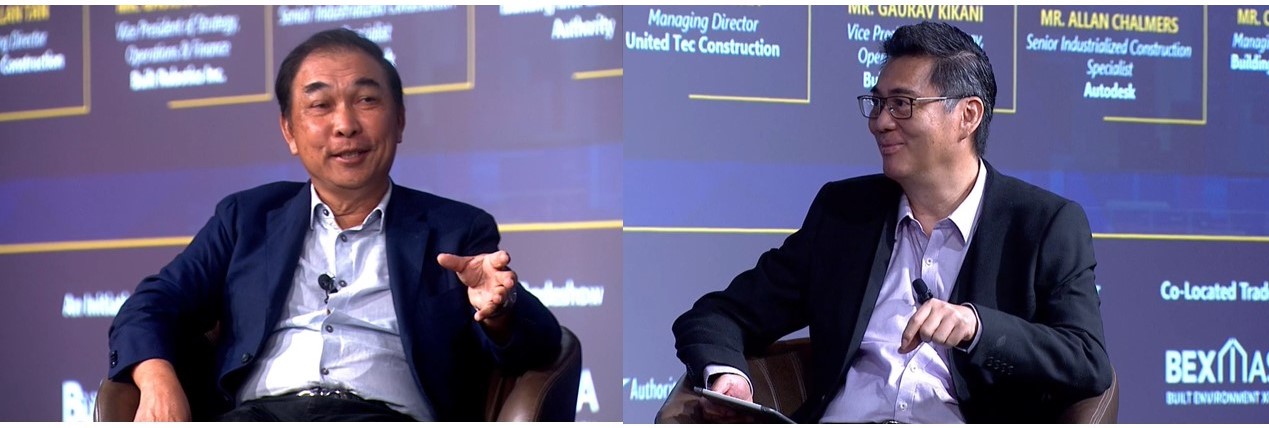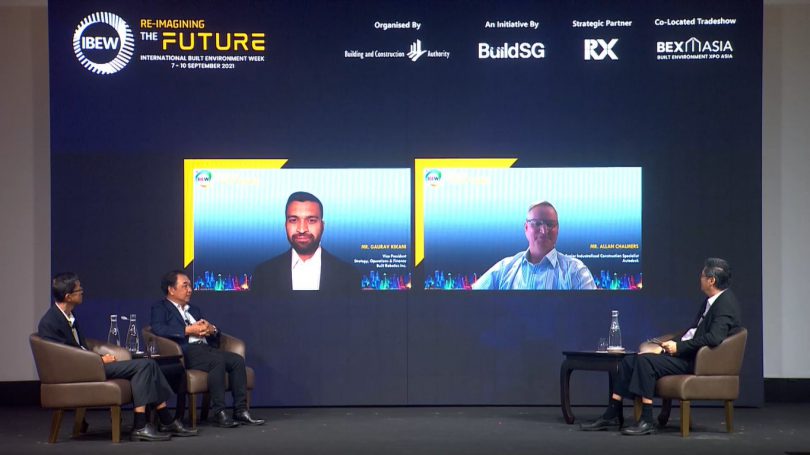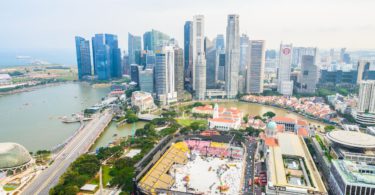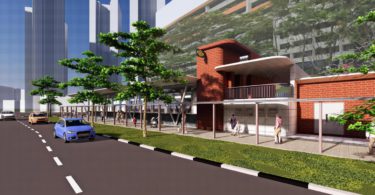The industry experts in International Built Environment Week 2021 shared how leading firms are leveraging innovation such as Prefabricated Prefinished Volumetric Construction (PPVC), Design for Manufacturing and Assembly (DfMA), robotics and automatons drive productivity improvement and develop cutting edge capabilities. They also answered some burning questions from the audience and below are some of the excerpts.
Building with PPVC
Allan Tan founded United Tec Construction Pte Ltd in 2018. It specialises in and capitalises on the market potential of PPVC and is currently constructing the tallest PPVC building in the world: Avenue South Residence. The two 192-metre-tall residential towers are located in the residential district in Bukit Merah, Singapore, designed to create 988 apartments from almost 3,000 vertically stacked modules. The construction began in mid-2020 and it is expected to finish by Q1 2023.
Tan believes that the keys to his success are building a professional team; demonstrating capability to build client’s confidence; having regular and reliable PPVC supply chain; and ensuring continuous improvement and innovation on PPVC technology and methods, such as 3D PPVC carcass, 4D simulation and drone footage.

Left: Allan Tan; right: Cheng Tai Fatt, BCA
Q: Can a building be demolished in a modular manner like how it is constructed and modules be reused in another building?
AT: In the long term, this is possible. Some of my clients actually reused the modules in another location, for another show flat. What I am trying to say is, you don’t need to demolish, you can actually go along the joint and remove it carefully and you can reuse it. It is possible. But in terms of future buildings in the years to come—for example, a high-rise building—frankly speaking, nobody has tested it yet. The way I see it, the technology is changing and you can see people are using the robotics doing this and that. In my opinion, one day it is possible and we can use the module back for another project.
Shaping BE through robotics R&D
Professor Quek Tong Boon, Chief Executive, National Robotics Programme (NRP) believes that, in order to mitigate Singapore’s resource limitations, surfing the robotics wave is inevitable. However, we could also harness our strength to shape the robotics wave too. NRP’s vision is therefore, to create vibrant SG robotics ecosystem, with high capabilities and right applications to create meaningful economic and social impacts.
He also mentioned that data on robot density in manufacturing industry in 2019, based on research by International Federation of Robotics, show that on average, per 10,000 employees in the world, there are 113 robots’ installation. Singapore is substantially higher than the world’s average—at 918. Most of the robots built are for industrial applications, particularly manufacturing, but many opportunities also exist outside manufacturing and in the service industry, including from healthcare, environmental service and built environment (BE) sector.
In Singapore, in the Construction Industry Transformation Map, the opportunities for robotics lie in two of the key areas: Integrated Digital Delivery (IDD) and Design for Manufacturing and Assembly (DfMA), which require highly automated off-site production facilities, and efficient and clean on-site installation process. Examples of the on-going NRP projects are: robot assisted supervision and monitoring on construction progress; high load agile mobile manipulation system; on-site automated system for installation of prefabricated units; automated robotic-BIM inspection system, site monitoring robot. Robotics are even used for cleaning, mapping and inspections, such as: modular staircase reconfigurable staircase climbing robot; glass façade cleaning robot, drain inspection robot, pavement cleaning vehicle with adaptive width and many more.

Left: Prof Quek; right: Gaurav Kikani
Robotics and automatons require extra investment and may be costly for contractors to adopt, operate and maintain. Is it practical for contractors to adopt these solutions and how do we convince them?
QTB: I think it is a very complex challenge because if you look at the construction ecosystem today, actually it is quite fragmented. It is made up of different tiers. So, we do have to look at the most appropriate levels—the targets of the technology. For example, the crane robotics are obviously not something contractors want to adopt because it is crane business; so, a more appropriate adopter is the crane manufacturer. We can give incentive to someone in the manufacturer who can adopt this. I think this would make more sense. First, they know their cranes better. Then, with economy of scale, when they lease out the crane to service providers, the price would be more affordable. Secondly, the capital for robotics is quite high upfront. One model could be this: instead of having users buy robots, we can explore the idea of robotics as a service. For example, people pay by the hour of the robotics services. Therefore, contractors do not have to own the capital equipment.
Read: Prototype climbing robots care for the plants at the Singapore Pavilion at Expo 2020 Dubai
Robots that build the world
Gaurav Kikani, Vice President of Strategy, Operations and Finance of Built Robotics Inc., believes that technology has evolved from continuous tracked machine to hydraulics, to GPS and finally digital technology. The latest consist software that enables tools to complete projects faster and more profitability. Now the robots handle trenches for electrical cables, pipelines and other buried infrastructure around the world.
This has allowed for safer jobsites as workers no longer need to do dangerous works. They could supervise unmanned equipment instead. Contractors can then grow their business by allocating their best people to the highest value tasks. They could also increase profitability because robots can help optimise works, ensure on-time project delivery and boost efficiency by extending hours and reducing timelines.
Read: Construction Robotics: The Role Robotics Play In Singapore’s Construction Landscape
If you want to invest one last dollar on innovation, what would it be and why?
GK: If you have one more dollar to invest in innovation, you want to start with something that you could follow through. To the points that were being made earlier, innovation is hard and scary. There is a financial and operational risk, particularly in construction. You want to put your dollar in something you really want to embrace and see it through. It will take time—but innovation does not happen overnight and never has. Technology and the next generation of technology in construction are really going to help differentiate contractors. New methods that contractors could adopt, embrace—and integrate the fastest and most comprehensively–will give benefits and contractors will definitely reap the rewards.
– Construction+ Online











